Why you should be performing office hysteroscopy… now
Office hysteroscopy (OH) remains a valuable but underutilized tool in evaluation and treatment of abnormal uterine bleeding. Fostering a clinic environment in which patients have access to a “one-stop shopping” experience has benefits for both them and the gynecologist. as well as the medical system.
S. Tara Scope is a healthy 29-year-old nulliparous patient who presents to your gynecology clinic for an initial patient visit due to recent onset of mid-cycle spotting. She is engaged to be married and hoping to conceive within the next year. She has always had regular menstrual cycles and is currently on cycle day 7. As a busy professional, it is difficult for her to miss work and she is seeking a health care provider that can diagnose and possibly treat her condition during her initial visit.
After reviewing her medical history, you determine that Ms. Scope has an unremarkable past medical history, is on no medications, and has very regular cycles. Her body mass index is 21 and the remainder of her gynecologic exam is normal. The next appropriate step is for her to have a vaginal ultrasound, which shows an endometrial echo of 1.5 cm, which is unusual for cycle day 7. Her myometrium and her ovary scan are normal. The Doppler flow suggests the presence of an intrauterine polyp (Figure 1). After consent is obtained, a vaginoscopic polpectomy is performed in less than 10 minutes. The patient rests for 5 additional minutes to allow her cramping to subside and then returns to work for the remainder of the afternoon.
Introduction
Office hysteroscopy (OH) remains a valuable but underutilized tool in evaluation and treatment of abnormal uterine bleeding.1 Fostering a clinic environment in which patients have access to a “one-stop shopping” experience has benefits for both them and the gynecologist,2-5 as well as the medical system.6,7 In our minimally invasive gynecologic surgery (MIGS) clinic with only two providers, we perform approximately 15 OHs each week while we see our normal patient schedule. Despite being the gold standard for evaluation of endometrial pathology,8-11 it has been estimated that fewer than 1 in 5 gynecologists routinely perform OH.1 In this article, we will walk through how to set up a clinic practice that allows for a same-day “see and treat” approach with OH.
Who benefits from diagnostic and procedural OH?
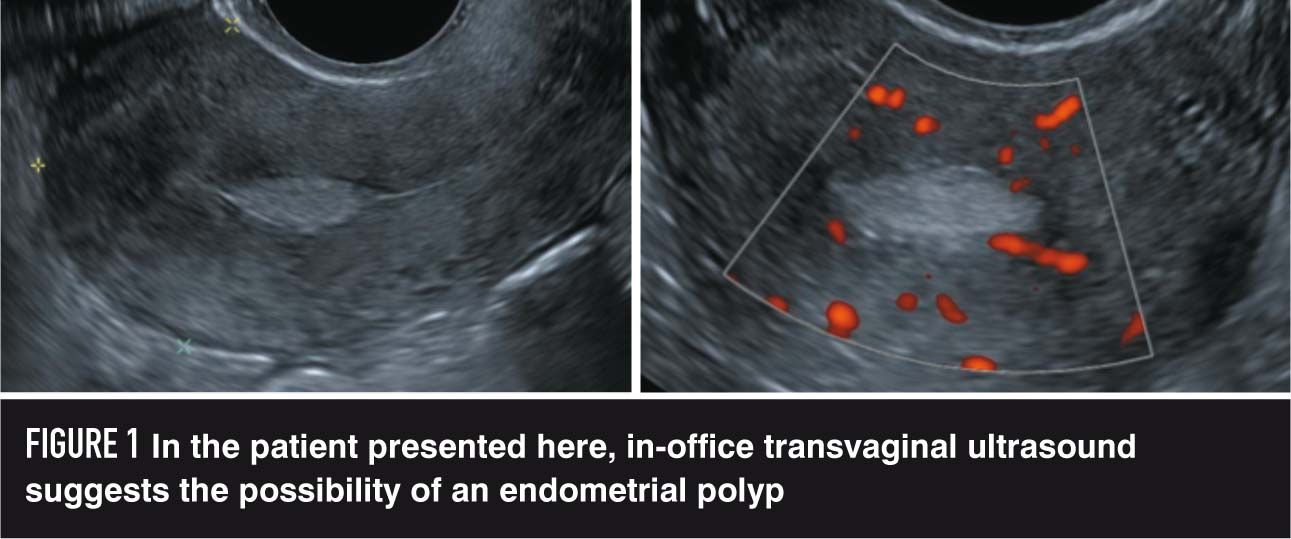
Many patients can benefit from use of OH (Table 1). Abnormal uterine bleeding (AUB) accounts for roughly one-third of annual gynecological office visits for premenopausal women and 70% of annual visits for perimenopasal or menopausal women.12 Women with AUB who are ovulatory most often suffer from intrauterine pathology such as polyps, myomata, and adenomyosis, which can easily be diagnosed and often treated with OH. In particular, patients with myomata benefit from OH. It is important to know if the myoma is a Type 0, I, II or III before going to the operating room for removal and only OH will give the same view as the operative resectoscope. In postmenopausal women with recurrent bleeding, an endometrial echo less than 5 mm, and a normal endometrial biopsy, OH is valuable for detecting and treating focal lesions. Blind endometrial biopsies and curettages can miss over 30% of focal endometrial lesions, including endometrial cancer.13,14

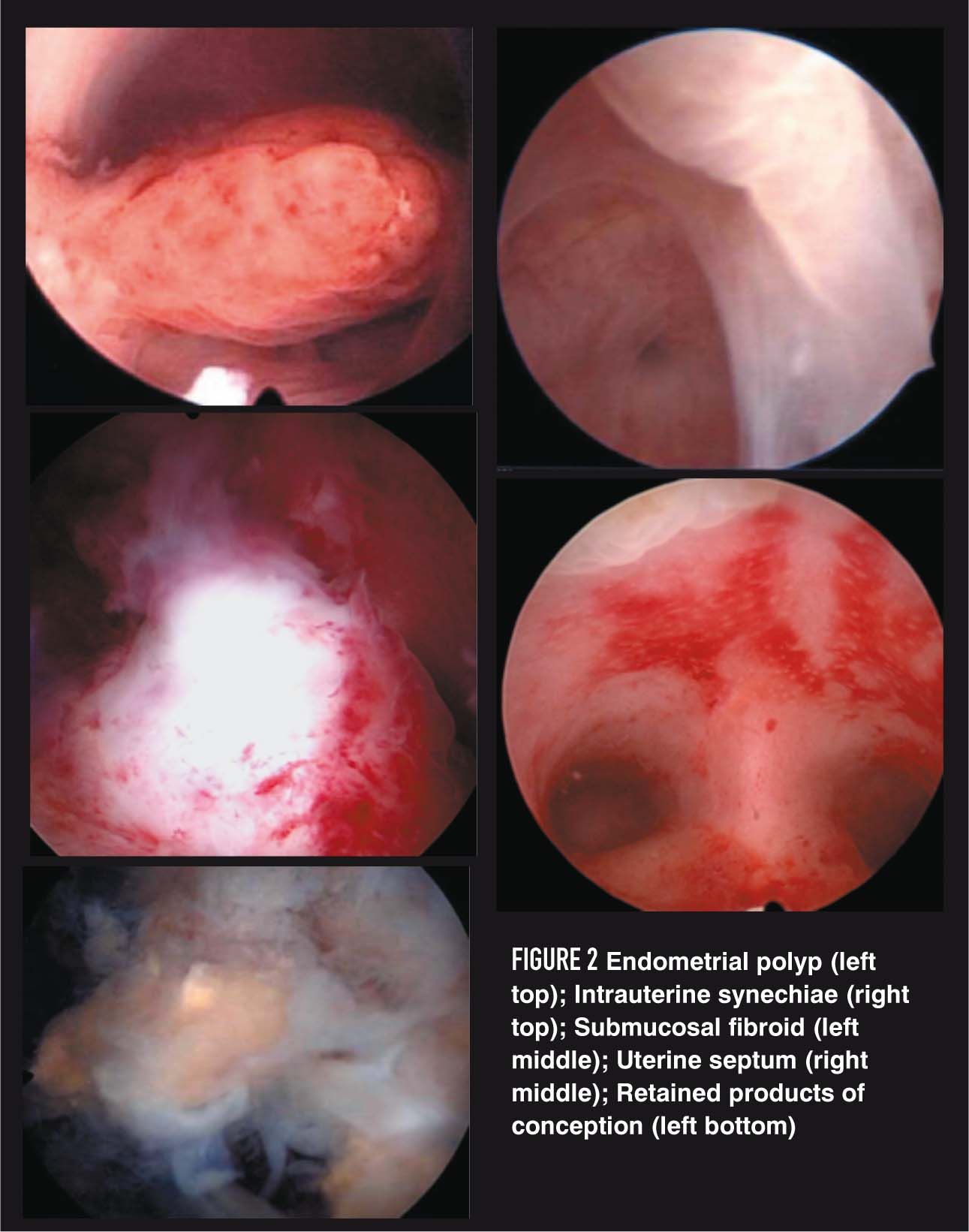
Because intrauterine devices have recently become more commonplace for contraception and to control heavy painful menses, we are losing more strings. OH is a simple, quick tool for retrieving these devices.15 In addition, OH is helpful as part of an infertility workup. Twenty percent to 45% of women with infertility have intrauterine pathology, including small polyps, uterine septa, adhesions, adenomyosis, and myomata.16,17 In summary, OH can be used to diagnose and treat a variety of pathologies (Figure 2). Busy gynecologic practices are very likely to have an adequate volume of patients who will benefit from the addition of OH.
NEXT: Equipment needed to start an OH program
Equipment needed to start an OH program
The minimal equipment needed to perform OH includes a hysteroscope, a light source, a camera and monitor, a system for uterine distention, and facilities to clean and sterilize the instrumentation. Helpful, but not essential, is an image/video capture device and a fluid management system, including a specifically designed office fluid pump and a fluid collection system.
Hysteroscopes
Define your mission. Do you want to perform only diagnostic procedures or will you soon offer hysteroscopic procedures in the office? Diagnostic hysteroscopes are ones that have the benefit of a small diameter (3mm) but the disadvantage of only a single channel used for uterine distention (Figure 3). Rigid rod lens scopes are reusable and will last indefinitely if well maintained. However, these small scopes are fragile and can break easily. The most common lens angles are 12 and 30 degrees. The surgeon should try all three and determine his or her preference. The 12-degree lens may be easiest to master and is closest to the 0 degree view typically used with laparoscopy, but a 25- or 30-degree has the advantage of an angled view of the cornua once inside the cavity.

Three-millimeter flexible hysteroscopes have been available since the early 1990s. These are single-channel hysteroscopes that have a 0-degree lens angle but can be deflected from 90 to 120 degrees with a thumb manipulator (Figure 3). Some studies have shown decreased pain but longer procedure times with flexible hysteroscopes.18,19 No cervical tenaculum typically is needed when using a flexible hysteroscope but it is not easy to work with the device with a vaginoscopic technique.
New all-in-one hysteroscopes have a disposable component. The Endosee offered by Cooper Surgical costs about $150. and has a disposable sheath, integrated portable camera, monitor, and a light source that is about the size of an iPhone. It is currently the only single-channel instrument available. Lina is awaiting approval from the US Food and Drug Administration for its completely disposable hysteroscopic 4-mm OH system, which has a 5 Fr working channel (Figure 4). The estimated cost will be between $200 and $250.
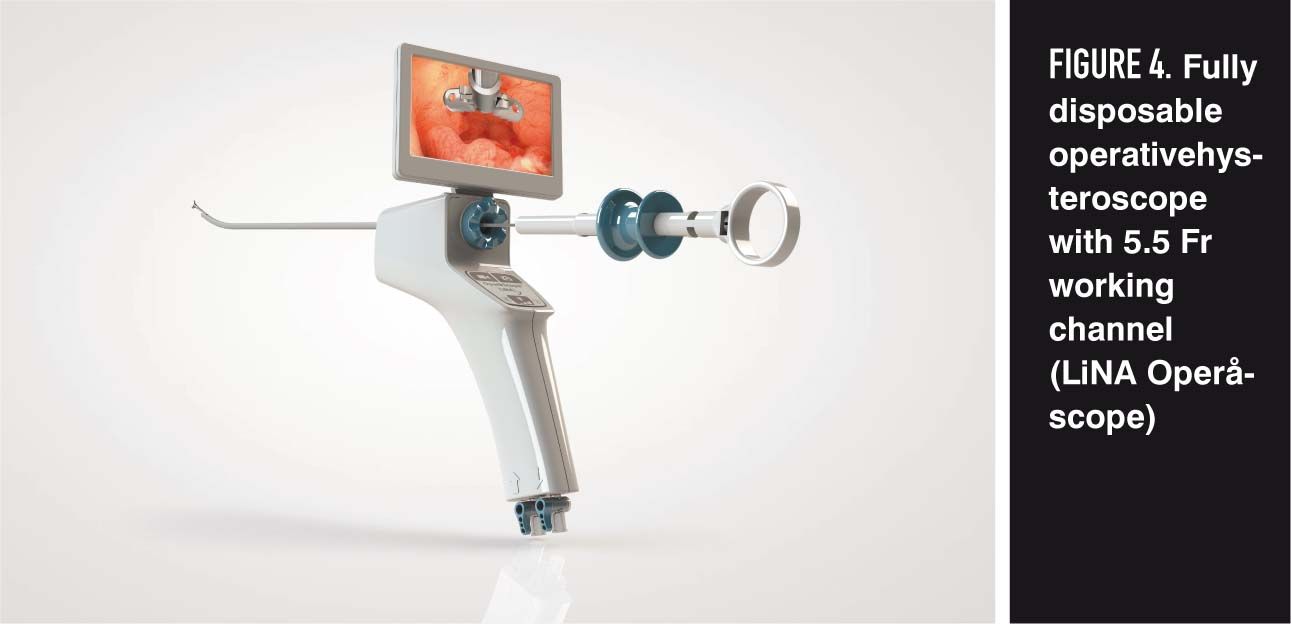
Operative hysteroscopes must have a working channel to allow for continuous flow of the distention media and passage of the semi-rigid instruments. The working channel should be the outflow channel and not the inflow channel so that uterine distention can be maintained when the instrument is being used. The diameter of the outer sheath should be as small as possible (4.5 mm-5.5 mm) to allow for passage through the cervix with minimal or no cervical dilatation. Such hysteroscopes are the ones most commonly used for vaginoscopic procedures because rigidity, continuous flow, and a working channel are required.
Operative hysteroscopes allow for treatment of a variety of pathologies, including resection of endometrial polyps and small submucosal fibroids, removal of retained products of conception and foreign bodies, and lysis of intrauterine adhesions (Table 2). All of these procedures are accomplished typically with semi-rigid 5 Fr instruments, including blunt and sharped tipped scissors, graspers, and a tenaculum to remove pathology after it has been detached from the endometrial surface. More experienced providers with additional resources and facilities may perform more advanced operative procedures including Type 1 and 2 fibroids. For our scope of practice, we have elected not to use energy in the office setting

Uterine distention and fluid management systems
Normal saline is the uterine distention medium of choice for office hysteroscopy.20 To obtain uterine distention, an intrauterine pressure between 45 mmHg and 80 mmHg is needed. It is not necessary to measure the intrauterine pressure. As a rule, the minimal pressure to obtain uterine distention is the pressure that should be used. Any additional pressure will cause the patient unnecessary discomfort. When a single-channel system is used without vaginoscopy, a 60-mL syringe connected to intravenous tubing is sufficient to achieve this distention. The assistant can see determine the minimal pressure needed back off on pressure if the patient is uncomfortable. Of note, it may be useful to have a higher pressure during the entry phase to open the cervical canal, turning down the pressure once the hysteroscope is advanced past the internal os.
When performing vaginoscopy or continuous-flow hysteroscopy, a higher volume of distention media is needed. The ideal system is a low-cost non-peristaltic pump with a disposable tubing/drape system that will collect the fluid so it can be measured easily, if needed (Figure 5). The pump has the advantage of maintaining constant pressure and freeing the assistant from having to manually pump or change the 1-L or 3-L fluids bags.
The alternative to a pump is a manual pressure cuff. That has the disadvantage of losing pressure as the procedure is performed and requires a dedicated assistant to manage the distention process.
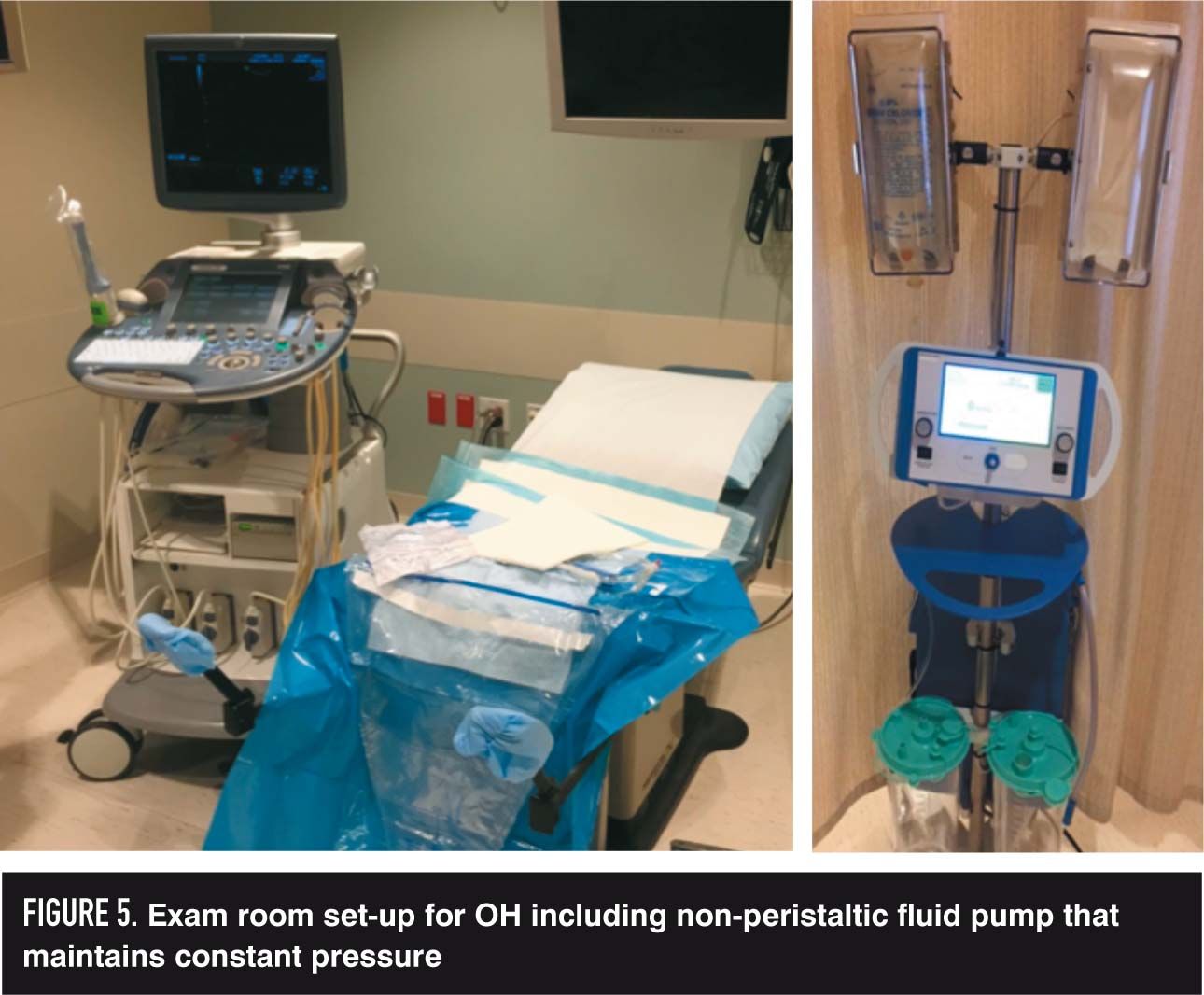
NEXT: Cleaning and sterilization
Cleaning and sterilization
Protocols may vary based on readily available equipment and regulatory requirements. In our office,the equipment is cleaned with an enzymatic soap and then soaked in Cidex OPA (which has no fumes) for at least 12 minutes at 20∙ºC21. This provides the sterilization necessary for reuse every 30 minutes.
No procedure room is necessary to begin office hysteroscopy
Having a safe and efficient set up is essential to incorporating OH into a busy gynecology clinic. It is not necessary to equip and staff a procedure room for basic OH such as is described in this article. All that is needed is a standard examination room (Figure 5). The examination table is prepared with an under-buttocks drape and pouch. To ensure a rapid turnover, it is important to train the personnel that will be responsible for setting up the hysteroscopic equipment, monitoring the patient, managing the fluid inflow and outflow, and cleaning the room and equipment. In general, using only one set of completely reusable OH tools, we have found that a procedure can be scheduled every 30 minutes.

Minimizing patient discomfort during OH
Appropriate patient selection is an important first step when planning OH. The procedure is not appropriate for patients with known endometrial cancer, viable intrauterine pregnancies, or any acute pelvic infection. For optimal view of the endometrial cavity, patients for OH are scheduled between cycle days 4 and 11 but as soon as cessation of flow is desirable. All patients are involved in a fully-informed consent process before proceeding with OH. In agreement with published studies,22,23 the vast majority of our patients prefer to proceed with same-day OH. However, some patients with significant anxiety opt for hysteroscopy in the operating room under anesthesia.
Even without using oral or local anesthesia, over 90% of patients can successfully undergo a diagnostic hysteroscopy and over 70% have successful operative OH. Patients are offered ibuprofen to help reduce cramping. They are also given a heat pack placed over the lower abdomen and offered a handheld stress ball to squeeze. Music is on during the procedure, as this has been shown to reduce pain scores and anxiety during OH.24
After cleansing the vagina and cervix with betadine, we use vaginoscopy for the majority of OH patients. This no-touch technique involves inserting the hysteroscope directly into the vagina without a speculum, tenaculum, or cervical block. The vagina is distended with normal saline and the hysteroscope is first advanced into the posterior fornix. With slight withdrawal of the hysteroscope, the cervix will come into view, typically anteriorly. The hysteroscope is then gently advanced through the external os. Rotation of the light handle of a rigid hysteroscope can help to guide the scope through the cervical canal by taking advantage of the angled lens, which facilitates navigating the normal flexion of the uterus.
With vaginoscopy, there is no need for a speculum, which helps to decrease patient discomfort. Eliminating the cervical block is also helpful for reducing pain, as many patients have significant pain with injection of the local anesthesia.25-26 The hydrodistension also helps to successfully enter the endometrial cavity even in patients who are postmenopausal, nulliparous, or who have cervical stenosis. Large studies involving thousands of patients have found that a vaginoscopic approach allows successful access to the endometrial cavity with decreased pain compared to traditional hysteroscopy with a speculum.27-31
It is uncommon, but occasionally a patient will require cervical dilation to allow passage of the hysteroscope. In these cases, a speculum and paracervical block are used, since cervical blocks have been shown to decrease pain from cervical dilation.31 Patients are also counseled that they can choose to stop the OH at any time if they experience too much discomfort.
Some studies have shown benefits of cervical preparation with vaginal misoprostol before OH.33-35 However, a meta-analysis of randomized controlled trials evaluating use of cervical preparations to reduce pain during outpatient hysteroscopy showed no reduction in pain in premenopausal or postmenopausal women who required cervical dilation of 5 mm or less.36 We do not routinely use any cervical preparation, since in our experience, most patients do not require cervical dilation with our vaginoscopic approach and pre-procedure misoprostol can be associated with bothersome side effects such as pre-procedural cramping and greater leaking of fluid.37
NEXT: Prepare for complications and medical emergencies
Prepare for complications and medical emergencies
OH is a safe procedure with a complication rate of less than 1%.38 However, unusual events such as severe vagal reactions, drug allergies and overdose, uterine perforation, bleeding and various cardiac events do occur. The physician and his or her team has to practice and be prepared to handle these medical emergencies. It is recommended that each room in which OH is performed contain a binder with “crisis check list”. These lists help identify the emergency and provide step-by-step instruction on how to manage the condition, including the proper medications and dosage. These lists are available online free of charge, or your office may want to develop their own.
OH is beneficial for patient and provider
OH is an important component of patient-centered care. By moving hysteroscopy from the operating room to the office without anesthesia, not only do patients avoid the dangers of anesthesia but the number of office visits required to diagnose and treat intrauterine pathology and days off from work is reduced. OH remains an excellent option for patients with multiple comorbidities who may be poor surgical candidates for the anesthesia associated with traditional hysteroscopy in the operating room. Patient satisfaction is further increased because unlike an OR procedure where they are heavily sedated, they have the option of seeing images of their cervix and uterine cavity and any pathology present.
OH also offers numerous advantages to physicians, including avoidance of OR procedures, streamlined office flow, rapid diagnosis, and increased reimbursement. The traditional operative procedure model incurs out-of-office time for travel, paperwork and perioperative time, which is not reimbursed. Performing hysteroscopy and biopsy simultaneously in the office allows physicians to code and bill for both a diagnostic and an operative hysteroscopy at the same time. Reimbursement for these procedures is higher than for a simple endometrial biopsy and more information can be obtained through direct visualization. Proper CPT coding showing what procedure was done and where it occurred allows physicians to collect a higher procedure fee and insurance companies avoid the facility fee that would normally go to the hospital for use of OR facilities, equipment and personnel. A recent study demonstrated a cost savings of $1498 per patient for women who underwent diagnostic OH and subsequently did not require additional OR procedures.6 Your organization may be able to negotiate higher reimbursement with different insurance payers by showing the cost savings of OH for patients who do not subsequently have to go to the OR.
RVUs (Resource Value Units) are a component of the Resource Based Relative Value Scale (RBRVS) set by the Centers for Medicare & Medicaid Services (CMS) to reimburse physicians and are constantly being reevaluated. A total RVU is calculated for each CPT code and is based on the sum of 3 elements: physician work, practice expense, and malpractice cost.39 Payment is then based on the sum of the three types of RVUs, adjusted for to account for geographical variation in the cost of practicing medicine, multiplied by a conversion factor. This information is updated on a quarterly basis. Commercial payers use the RBRVS system to calculate their own reimbursement rates which may be above or below Medicare rates. As of July 3, 2017, the total RVUs for CPT code 58558 for OH with sampling (biopsy) of the endometrium and/or polypectomy increased from 11.44 RVU in 2016 to 38.51 RVUs.40 This reflects a 237% increase over 2016. The same procedure (CPT 58558) performed in a facility (hospital OR or surgical center) RVU decreased from 7.56 in 2016 to 6.72 in 2017.40This reflects an 11% decrease.40This suggests that insurance carriers recognize the benefits of OH and are committed to facilitating and incentivizing its increased use. Pricing Information and RVU data can be found on the CMS website www.cms.gov under the Physician Fee Schedule Search Tool.
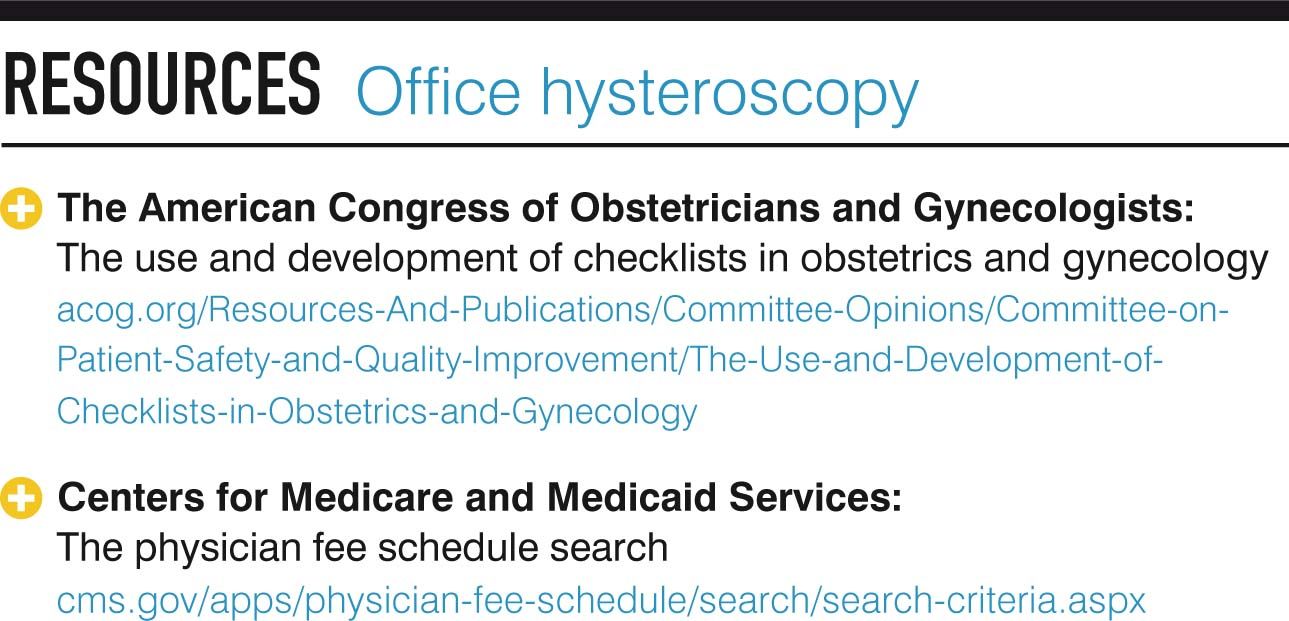
Conclusion
Rarely in medicine do we come across a procedure that is a win-win for all involved. OH may be best for a patient because it allows for an efficient “see and treat” model that facilitates diagnosis and removal of pathology with minimal disruption to her lifestyle. OH is a tool that should be a daily feasible option for all gynecologists that optimizes office workflow, patient satisfaction, and reimbursement strategies. It is both an efficient and effective use of office time that streamlines and accelerates the diagnosis and treatment process while maximizing reimbursement and RVUs for physicians. Incorporating OH also provides friendly patient-centered care with minimal discomfort, reduced risk of anesthesia, and the convenience of diagnosis and treatment in a single visit. As advancements in technology make OH cheaper and easier, and with increased reimbursement strategies, OH is destined to become a more widely adopted component of general gynecological office-based practice.
NEXT: References
REFERENCES
Isaacson K. Office hysteroscopy: a valuable but under-utilized technique. CurrOpinObstetGynecol. 2002 Aug 1;14(4):381-5.
Kremer C, Duffy S, Moroney M. Patient satisfaction with outpatient hysteroscopy versus day case hysteroscopy: randomised controlled trial. BMJ. 2000 Jan 29;320(7230):279-82.
Abbasi I, Oliver J, Jones T, Ewies A. Office diagnostic and operative hysteroscopy service–patient satisfaction survey. EuropJf ObstetGynecolReprodBiol. 2016 Nov 1;206:e128.
Cooper NA, Middleton L, Smith P, Denny E, Stobert L, Daniels J, Clark TJ. A patient-preference cohort study of office versus inpatient uterine polyp treatment for abnormal uterine bleeding. Gynecoll Surg. 2016 Nov 1;13(4):313-22.
Keyhan S, Munro MG. Office diagnostic and operative hysteroscopy using local anesthesia only: an analysis of patient reported pain and other procedural outcomes. JMinimInvasiveGynecol. 2014 Oct 31;21(5):791-8.
Moawad NS, Santamaria E, Johnson M, Shuster J. Cost-effectiveness of office hysteroscopy for abnormal uterine bleeding. JSLS. 2014 Jul;18(3).
Hidlebaugh D. A comparison of clinical outcomes and cost of office versus hospital hysteroscopy. JAmAssocGynecolLaparoscop. 1996 Nov 1;4(1):39-45.
Van Dongen H, De Kroon CD, Jacobi CE, Trimbos JB, Jansen FW. Diagnostic hysteroscopy in abnormal uterine bleeding: a systematic review and metaâ€Âanalysis. BJOG. 2007 Jun 1;114(6):664-75.
Preutthipan S, Linasmita V. A prospective comparative study between hysterosalpingography and hysteroscopy in the detection of intrauterine pathology in patients with infertility. JObstetGynaecolRes. 2003 Feb 1;29(1):33-7.
Gkrozou F, Dimakopoulos G, Vrekoussis T, Lavasidis L, Koutlas A, Navrozoglou I, Stefos T, Paschopoulos M. Hysteroscopy in women with abnormal uterine bleeding: a meta-analysis on four major endometrial pathologies. ArchivesGynecolObstet. 2015 Jun 1;291(6):1347-54.
Mairos J, Di Martino P. Office Hysteroscopy. An operative gold standard technique and an important contribution to Patient Safety. Gynecological surgery. 2016 May 1;13(2):111-4.
Diagnosis of abnormal uterine bleeding in reproductive-aged women. Practice Bulletin No. 128. American College of Obstetricians and Gynecologists. Obstet Gynecol. 2012;120:197–206.
Epstein E, Ramirez A, Skoog L, Valentin L. Dilatation and curettage fails to detect most focal lesions in the uterine cavity in women with postmenopausal bleeding. Acta obstetricia et gynecologica Scandinavica. 2001 Dec 1;80(12):1131-6.
Ferry J, Farnsworth A, Webster M, Wren B. The efficacy of the pipelle endometrial biopsy in detecting endometrial carcinoma. Australian and New Zealand Journal of Obstetrics and Gynaecology. 1993 Feb 1;33(1):76-8.
Mehta S, Schwartz M, Fridman D, Levie M, To J, Chudnoff S. Office Hysteroscopy for the Removal of a Retained Intrauterine Device. JMinimInvasiveGynecol. 2015 Nov 1;22(6):S183.
Fatemi HM, Kasius JC, Timmermans A, van Disseldorp J, Fauser BC, Devroey P., Broekmans FJ. Prevalence of unsuspected uterine cavity abnormalities diagnosed by office hysteroscopy prior to in vitro fertilization. HumanReprod. 2010;25(18) 1959-1965.
Hinkley MD, Milki AA. 1000 office-based hysteroscopies prior to in vitro fertilization: feasibility and findings. JSLS. 2004;8:103-107.
Unfried G, Wieser F, Albrecht A, Kaider A, Nagele F. Flexible versus rigid endoscopes for outpatient hysteroscopy: a prospective randomized clinical trial. Human Reprod. 2001 Jan 1;16(1):168-71.
Agostini A, Bretelle F, Cravello L, Maisonneuve AS, Roger V, Blanc B. Acceptance of outpatient flexible hysteroscopy by premenopausal and postmenopausal women. JReprodMed. 2003 Jun;48(6):441-3.
Worldwide AA. AAGL practice report: practice guidelines for the management of hysteroscopic distending media:(replaces hysteroscopic fluid monitoring guidelines. J Am Assoc Gynecol Laparosc. 2000; 7: 167–168.). JMinimInvasiveGynecol. 2013 Apr 30;20(2):137-48.
Cidex OPA Solution, ortho-Phthalaldehyde high level disinfectant for semi-critical medical devices. Johnson and Johnson Health Care Systems Inc. eIFU Site: https://www.e-ifu.com/index.aspx?langID=1&
van Dongen H, Timmermans A, Jacobi CE, Elskamp T, de Kroon CD, Jansen FW. Diagnostic hysteroscopy and saline infusion sonography in the diagnosis of intrauterine abnormalities: an assessment of patient preference. GynecolSurg. 2011 Feb 1;8(1):65-70.
Wortman M, Daggett A, Ball C. Operative hysteroscopy in an office-based surgical setting: review of patient safety and satisfaction in 414 cases. JMinimInvasiveGynecol. 2013 Feb 28;20(1):56-63.
Angioli R, Nardone CD, Plotti F, Cafà EV, Dugo N, Damiani P, Ricciardi R, Linciano F, Terranova C. Use of music to reduce anxiety during office hysteroscopy: prospective randomized trial. JMinimInvasiveGynecol. 2014 Jun 30;21(3):454-9.
Lau WC, Lo WK, Tam WH, Yuen PM. Paracervical anaesthesia in outpatient hysteroscopy: a randomised doubleâ€Âblind placeboâ€Âcontrolled trial. BJOG. 1999 Apr 1;106(4):356-9.
Giorda G, Scarabelli C, Franceschi S, Campagnutta E. Feasibility and pain control in outpatient hysteroscopy in postmenopausal women: a randomized trial. ActaObstetGynecolScand. 2000 Jan 1;79(7):593-7.
Bettocchi S, Selvaggi L. A vaginoscopic approach to reduce the pain of office hysteroscopy. JAmAssocGynecolLaparoscop. 1997 Feb 1;4(2):255-8.
Sagiv R, Sadan O, Boaz M, Dishi M, Schechter E, Golan A. A new approach to office hysteroscopy compared with traditional hysteroscopy: a randomized controlled trial. ObstetGynecol. 2006 Aug 1;108(2):387-92.
Cooper NA, Smith P, Khan KS, Clark TJ. Vaginoscopic approach to outpatient hysteroscopy: a systematic review of the effect on pain. BJOG. 2010 Apr 1;117(5):532-9.
Garbin O, Kutnahorsky R, Göllner JL, Vayssiere C. Vaginoscopic versus conventional approaches to outpatient diagnostic hysteroscopy: a two-centre randomized prospective study. HumanReprod. 2006 Jul 14;21(11):2996-3000.
Sardo AD, Taylor A, Tsirkas P, Mastrogamvrakis G, Sharma M, Magos A. Hysteroscopy: a technique for all? Analysis of 5,000 outpatient hysteroscopies. FertilSteril. 2008 Feb 29;89(2):438-43.
Chudnoff S, Einstein M, Levie M. Paracervical block efficacy in office hysteroscopic sterilization: a randomized controlled trial. ObstetGynecol. 2010 Jan 1;115(1):26-34.
Atay V, Duru NK, Aydin BA. Vaginal misoprostol for cervical dilatation before operative office hysteroscopy. GynaecolEndoscopy. 1997 Feb 1;6(1):47-9.
Sordia-Hernández LH, Rosales-Tristan E, Vazquez-Mendez J, Merino M, Iglesias JL, Garza-Leal JG, Morales A. Effectiveness of misoprostol for office hysteroscopy without anesthesia in infertile patients. Fertili Steril. 2011 Feb 28;95(2):759-61.
El-Mazny A, Abou-Salem N. A double-blind randomized controlled trial of vaginal misoprostol for cervical priming before outpatient hysteroscopy. FertilSteri. 2011 Oct 31;96(4):962-5.
Zhuo Z, Yu H, Jiang X. A systematic review and meta-analysis of randomized controlled trials on the effectiveness of cervical ripening with misoprostol administration before hysteroscopy. IntJGynecolObstet. 2016 Mar 31;132(3):272-7.
Cooper N, Smith P, Khan K, Clark T. Does cervical preparation before outpatient hysteroscopy reduce women’s pain experience? A systematic review. BJOG 2011;118:1292–1301.
Capmas P, Pourcelot AG, Giral E, Fedida D, Fernandez H. Office hysteroscopy: A report of 2402 cases. JGynécolObstétBiologieReprod. 2016 May 31;45(5):445-50.
National Health Policy Forum: The Basics: Relative Value Units (RVUs). Retrieved from https://www.nhpf.org/library/the-basics/Basics_RVUs_01-12-15.pdf
Center for Medicare & Medicaid Services: Physician Fee Schedule Look-Up Tool: https://www.cms.gov/Medicare/Medicare-Fee-for-Service-Payment/PFSlookup/
Figure 1. In-office transvaginal ultrasound suggests the possibility of an endometrial polyp
Figure 2. Endometrial pathologies that can be found at time of diagnostic OH
Endometrial polyp
Intrauterine synechiae
Submucosal fibroid
Uterine septum
Retained products of conception
Figure 3. 3-mm rigid diagnostic hysteroscopes and flexible hysteroscope
Figure 4. Hysteroscopes with handheld video monitors
EndoSee diagnostic hysteroscope Disposable hysteroscope with 5 Fr working
(Cooper Surgical) channel (Lina)
Figure 5. Exam room set-up for OH including non-peristaltic fluid pump that maintains constant pressure
Table 1. Chief complaints of patients who can benefit from OH
Abnormal uterine bleeding
Intrauterine device problem (missing strings, displaced or embedded position)
Abnormality found in prior imaging study
Postmenopausal bleeding
Asherman’s syndrome
Retained products of conception
Infertility
Uterine septum
Table 2. Procedures that may be feasible with OH
Diagnostic hysteroscopy
Polypectomy
Lysis of adhesions
Removal of retained intrauterine device
Metroplasty
Removal of retained products of conception
Myomectomy (small type 0 fibroids)
Targeted endometrial biopsy
